|
Size: 26438
Comment:
|
Size: 32596
Comment:
|
| Deletions are marked like this. | Additions are marked like this. |
| Line 1: | Line 1: |
| = Sage Interactions - Number Theory = goto [:interact:interact main page] [[TableOfContents]] |
<<TableOfContents>> = Integer Factorization = == Divisibility Poset == by William Stein {{{#!sagecell @interact def _(n=(5..100)): Poset(([1..n], lambda x, y: y%x == 0) ).show() }}} {{attachment:divposet.png}} |
| Line 8: | Line 18: |
| {{{ | {{{#!sagecell |
| Line 41: | Line 51: |
| g += line([(j*2-len(cur),-i), ((k*2)-len(rows[i-1]),-i+1)], | g += line([(j*2-len(cur),-i), ((k*2)-len(rows[i-1]),-i+1)], |
| Line 53: | Line 63: |
| attachment:factortree.png == Continued Fraction Plotter == by William Stein {{{ @interact def _(number=e, ymax=selector([None,5,20,..,400],nrows=2), clr=Color('purple'), prec=[500,1000,..,5000]): c = list(continued_fraction(RealField(prec)(number))); print c show(line([(i,z) for i, z in enumerate(c)],rgbcolor=clr),ymax=ymax,figsize=[10,2]) }}} attachment:contfracplot.png |
{{attachment:factortree.png}} More complicated demonstration using Mathematica: http://demonstrations.wolfram.com/FactorTrees/ == Factoring an Integer == by Timothy Clemans Sage implementation of the Mathematica demonstration of the same name. http://demonstrations.wolfram.com/FactoringAnInteger/ {{{#!sagecell @interact def _(r=selector(range(0,10000,1000), label='range', buttons=True), n=slider(0,1000,1,2,'n',False)): if not r and n in (0, 1): n = 2 s = '$%d = %s$' % (r + n, factor(r + n)) s = s.replace('*', '\\times') html(s) }}} = Prime Numbers = |
| Line 67: | Line 86: |
| {{{ | {{{#!sagecell |
| Line 73: | Line 92: |
| attachment:primes.png == Computing Generalized Bernoulli Numbers == by William Stein (Sage-2.10.3) {{{ @interact def _(m=selector([1..15],nrows=2), n=(7,(3..10))): G = DirichletGroup(m) s = "<h3>First n=%s Bernoulli numbers attached to characters with modulus m=%s</h3>"%(n,m) s += '<table border=1>' s += '<tr bgcolor="#edcc9c"><td align=center>$\\chi$</td><td>Conductor</td>' + \ ''.join('<td>$B_{%s,\chi}$</td>'%k for k in [1..n]) + '</tr>' for eps in G.list(): v = ''.join(['<td align=center bgcolor="#efe5cd">$%s$</td>'%latex(eps.bernoulli(k)) for k in [1..n]]) s += '<tr><td bgcolor="#edcc9c">%s</td><td bgcolor="#efe5cd" align=center>%s</td>%s</tr>\n'%( eps, eps.conductor(), v) s += '</table>' html(s) }}} attachment:bernoulli.png == Fundamental Domains of SL_2(ZZ) == by Robert Miller {{{ L = [[-0.5, 2.0^(x/100.0) - 1 + sqrt(3.0)/2] for x in xrange(1000, -1, -1)] R = [[0.5, 2.0^(x/100.0) - 1 + sqrt(3.0)/2] for x in xrange(1000)] xes = [x/1000.0 for x in xrange(-500,501,1)] M = [[x,abs(sqrt(x^2-1))] for x in xes] fundamental_domain = L+M+R fundamental_domain = [[x-1,y] for x,y in fundamental_domain] @interact def _(gen = selector(['t+1', 't-1', '-1/t'], nrows=1)): global fundamental_domain if gen == 't+1': fundamental_domain = [[x+1,y] for x,y in fundamental_domain] elif gen == 't-1': fundamental_domain = [[x-1,y] for x,y in fundamental_domain] elif gen == '-1/t': new_dom = [] for x,y in fundamental_domain: sq_mod = x^2 + y^2 new_dom.append([(-1)*x/sq_mod, y/sq_mod]) fundamental_domain = new_dom P = polygon(fundamental_domain) P.ymax(1.2); P.ymin(-0.1) P.show() }}} attachment:fund_domain.png |
{{attachment:primes.png}} == Prime Spiral - Square FIXME == by David Runde {{{#!sagecell @interact def square_prime_spiral(start=1, end=100, size_limit = 10, show_lines=false, invert=false, x_cord=0, y_cord=0, n = 0): """ REFERENCES: Alpern, Dario. "Ulam's Spiral". http://www.alpertron.com.ar/ULAM.HTM Sacks, Robert. http://www.NumberSpiral.com Ventrella, Jeffery. "Prime Numbers are the Holes Behind Complex Composite Patterns". http://www.divisorplot.com Williamson, John. Number Spirals. http://www.dcs.gla.ac.uk/~jhw/spirals/index.html [email protected] Weisstein, Eric W. "Prime-Generating Polynomial." From MathWorld--A Wolfram Web Resource. http://mathworld.wolfram.com/Prime-GeneratingPolynomial.html """ #Takes an (x,y) coordinate (and the start of the spiral) and gives its corresponding n value def find_n(x,y, start): if x>0 and y>-x and y<=x: return 4*(x-1)^2 + 5*(x-1) + (start+1) + y elif x<=0 and y>=x and y<=-x: return 4*x^2 - x + (start) -y elif y>=0 and -y+1 <= x and y-1 >= x: return 4*y^2 -y + start -x elif y<0 and -x >= y and y<x: return 4*(y+1)^2 -11*(y+1) + (start+7) +x else: print 'NaN' #Takes in an n and the start value of the spiral and gives its (x,y) coordinate def find_xy(num, start): num = num - start +1 bottom = floor(sqrt(num)) top = ceil(sqrt(num)) if bottom^2 < num and num<=bottom^2+bottom+1: if bottom%2 == 0: x=-bottom/2 y=-x-(num-bottom^2)+1 else: x=bottom/2+1/2 y=-x + (num-bottom^2) else: if top%2 == 0: y=top/2 x=-top/2+1+top^2-num else: y=-top/2+1/2 x=top/2 -1/2 - (top^2-num) x = Integer(x) y = Integer(y) return (x,y) if start < 1 or end <=start: print "invalid start or end value" if n > end: print "WARNING: n is larger than the end value" #Changes the entry of a matrix by taking the old matrix and the (x,y) coordinate (in matrix coordinates) and returns the changed matrix def matrix_morph(M, x, y, set): N = copy(M) N[x-1,y] = set M = N return M #These functions return an int based on where the t is located in the spiral def SW_NE(t, x, y, start): if -y<x: return 4*t^2 + 2*t -x+y+start else: return 4*t^2 + 2*t +x-y+start def NW_SE(t, x, y, start): if x<y: return 4*t^2 -x-y+start else: return 4*t^2 + 4*t +x+y+start size = ceil(sqrt(end-start+1)) #Size of the matrix num=copy(start) # Start number (might not be used) x = ceil(size/2) #starting center x of the matrix (in matrix coordinates) y = copy(x) #starting center y of the matrix (in matrix coordinates) if n !=0: x_cord, y_cord = find_xy(n, start) #Overrides the user given x and y coordinates xt = copy(x_cord) yt = copy(y_cord) countx=0 county=0 overcount = 1 if size <= size_limit: M = matrix(ZZ, size+1) # Allows the numbers to be seen in the smaller matricies else: M = matrix(GF(2), size+1) # Restricts the entries to 0 or 1 main_list = set() #print x_cord, y_cord if show_lines: for t in [(-size-1)..size+1]: m= SW_NE(t, xt, yt, start) if m.is_pseudoprime(): main_list.add(m) m= NW_SE(t, xt, yt, start) if m.is_pseudoprime(): main_list.add(m) else: main_list = set(prime_range(end)) #This for loop changes the matrix by spiraling out from the center and changing each entry as it goes. It is faster than the find_xy function above. for num in [start..end]: #print x, "=x y=", y, " num =", num if countx < overcount: if overcount % 2 == 1: x+=1 else: x-=1 countx += 1 elif county < overcount: if overcount % 2 == 1: y+=1 else: y-=1 county += 1 else: overcount += 1 countx=2 county=0 if overcount % 2 == 1: x+=1 else: x-=1 if not invert and num in main_list: if size <= size_limit: M = matrix_morph(M, x, y, num) else: M = matrix_morph(M, x, y, 1) elif invert and num not in main_list: #This does the opposite of the above if statement by changing the matrix only when a number is not in the list of allowable primes if size <= size_limit: M = matrix_morph(M, x, y, num) else: M = matrix_morph(M, x, y, 1) if n != 0: print '(to go from x,y coords to an n, reset by setting n=0)' (x_cord, y_cord) = find_xy(n, start) #print 'if n =', n, 'then (x,y) =', (x_cord, y_cord) print '(x,y) =', (x_cord, y_cord), '<=> n =', find_n(x_cord, y_cord, start) print ' ' print "SW/NE line" if -y_cord<x_cord: print '4*t^2 + 2*t +', -x_cord+y_cord+start else: print '4*t^2 + 2*t +', +x_cord-y_cord+start print "NW/SE line" if x_cord<y_cord: print '4*t^2 +', -x_cord-y_cord+start else: print '4*t^2 + 4*t +', +x_cord+y_cord+start if size <= size_limit: show(M) #Displays the matrix with integer entries else: M.visualize_structure() # Displays the final resulting matrix as a series of pixels (1 <=> pixel on) #matrix_plot(M) }}} {{attachment:SquareSpiral.PNG}} == Prime Spiral - Polar == by David Runde {{{#!sagecell @interact def polar_prime_spiral(start=1, end=2000, show_factors = false, highlight_primes = false, show_curves=true, n = 0): #For more information about the factors in the spiral, visit http://www.dcs.gla.ac.uk/~jhw/spirals/index.html by John Williamson. if start < 1 or end <=start: print "invalid start or end value" if n > end: print "WARNING: n is greater than end value" def f(n): return (sqrt(n)*cos(2*pi*sqrt(n)), sqrt(n)*sin(2*pi*sqrt(n))) list =[] list2=[] if show_factors == false: for i in [start..end]: if i.is_pseudoprime(): list.append(f(i-start+1)) #Primes list else: list2.append(f(i-start+1)) #Composites list P = points(list) R = points(list2, alpha = .1) #Faded Composites else: for i in [start..end]: list.append(disk((f(i-start+1)),0.05*pow(2,len(factor(i))-1), (0,2*pi))) #resizes each of the dots depending of the number of factors of each number if i.is_pseudoprime() and highlight_primes: list2.append(f(i-start+1)) P = plot(list) p_size = 5 #the orange dot size of the prime markers if not highlight_primes: list2 = [(f(n-start+1))] R=points(list2, hue = .1, pointsize = p_size) if n > 0: print 'n =', factor(n) p = 1 #The X which marks the given n W1 = disk((f(n-start+1)), p, (pi/6, 2*pi/6)) W2 = disk((f(n-start+1)), p, (4*pi/6, 5*pi/6)) W3 = disk((f(n-start+1)), p, (7*pi/6, 8*pi/6)) W4 = disk((f(n-start+1)), p, (10*pi/6, 11*pi/6)) Q = plot(W1+W2+W3+W4, alpha = .1) n=n-start+1 #offsets the n for different start values to ensure accurate plotting if show_curves: begin_curve = 0 t = var('t') a=1 b=0 if n > (floor(sqrt(n)))^2 and n <= (floor(sqrt(n)))^2 + floor(sqrt(n)): c = -((floor(sqrt(n)))^2 - n) c2= -((floor(sqrt(n)))^2 + floor(sqrt(n)) - n) else: c = -((ceil(sqrt(n)))^2 - n) c2= -((floor(sqrt(n)))^2 + floor(sqrt(n)) - n) print 'Pink Curve: n^2 +', c print 'Green Curve: n^2 + n +', c2 def g(m): return (a*m^2+b*m+c); def r(m) : return sqrt(g(m)) def theta(m) : return r(m)- m*sqrt(a) S1 = parametric_plot(((r(t))*cos(2*pi*(theta(t))),(r(t))*sin(2*pi*(theta(t)))), begin_curve, ceil(sqrt(end-start)), rgbcolor=hue(0.8), thickness = .2) #Pink Line b=1 c= c2; S2 = parametric_plot(((r(t))*cos(2*pi*(theta(t))),(r(t))*sin(2*pi*(theta(t)))), begin_curve, ceil(sqrt(end-start)), rgbcolor=hue(0.6), thickness = .2) #Green Line show(R+P+S1+S2+Q, aspect_ratio = 1, axes = false) else: show(R+P+Q, aspect_ratio = 1, axes = false) else: show(R+P, aspect_ratio = 1, axes = false) }}} {{attachment:PolarSpiral.PNG}} = Modular Forms = |
| Line 127: | Line 307: |
| {{{ j = 0 @interact def _(N=[1..100], k=selector([2,4,..,12],nrows=1), prec=(3..40), |
{{{#!sagecell @interact def _(N=[1..100], k=selector([2,4,..,12],nrows=1), prec=(3..40), |
| Line 133: | Line 312: |
| print j; global j; j += 1 | |
| Line 145: | Line 323: |
| attachment:modformbasis.png | {{attachment:modformbasis.png}} |
| Line 150: | Line 328: |
| {{{ | {{{#!sagecell |
| Line 158: | Line 336: |
| attachment:cuspgroup.png | {{attachment:cuspgroup.png}} |
| Line 163: | Line 341: |
| {{{ | {{{#!sagecell |
| Line 171: | Line 349: |
| G = Graph(T, multiedges=True, loops=not three_d) | G = DiGraph(T, multiedges=not three_d) if three_d: G.remove_loops() |
| Line 180: | Line 360: |
| attachment:heckegraph.png == Demonstrating the Diffie-Hellman Key Exchange Protocol == by Timothy Clemans (refereed by William Stein) {{{ @interact def diffie_hellman(button=selector(["New example"],label='',buttons=True), bits=("Number of bits of prime", (8,12,..512))): maxp = 2^bits p = random_prime(maxp) k = GF(p) if bits>100: g = k(2) else: g = k.multiplicative_generator() a = ZZ.random_element(10, maxp) b = ZZ.random_element(10, maxp) print """ <html> <style> .gamodp { background:yellow } .gbmodp { background:orange } .dhsame { color:green; font-weight:bold } </style> <h2>%s-Bit Diffie-Hellman Key Exchange</h2> <ol style="color:#000;font:12px Arial, Helvetica, sans-serif"> <li>Alice and Bob agree to use the prime number p=%s and base g=%s.</li> <li>Alice chooses the secret integer a=%s, then sends Bob (<span class="gamodp">g<sup>a</sup> mod p</span>):<br/>%s<sup>%s</sup> mod %s = <span class="gamodp">%s</span>.</li> <li>Bob chooses the secret integer b=%s, then sends Alice (<span class="gbmodp">g<sup>b</sup> mod p</span>):<br/>%s<sup>%s</sup> mod %s = <span class="gbmodp">%s</span>.</li> <li>Alice computes (<span class="gbmodp">g<sup>b</sup> mod p</span>)<sup>a</sup> mod p:<br/>%s<sup>%s</sup> mod %s = <span class="dhsame">%s</span>.</li> <li>Bob computes (<span class="gamodp">g<sup>a</sup> mod p</span>)<sup>b</sup> mod p:<br/>%s<sup>%s</sup> mod %s = <span class="dhsame">%s</span>.</li> </ol></html> """ % (bits, p, g, a, g, a, p, (g^a), b, g, b, p, (g^b), (g^b), a, p, (g^ b)^a, g^a, b, p, (g^a)^b) }}} attachment:dh.png == Plotting an elliptic curve over a finite field == {{{ E = EllipticCurve('37a') @interact def _(p=slider(prime_range(1000), default=389)): show(E) print "p = %s"%p show(E.change_ring(GF(p)).plot(),xmin=0,ymin=0) }}} attachment:ellffplot.png == Prime Spiral - Square == by David Runde {{{ @interact def square_prime_spiral(start=1, end=100, size_limit = 10, show_lines=false, invert=false, x_cord=0, y_cord=0, n = 0): """ REFERENCES: Alpern, Dario. "Ulam's Spiral". http://www.alpertron.com.ar/ULAM.HTM Sacks, Robert. http://www.NumberSpiral.com Ventrella, Jeffery. "Prime Numbers are the Holes Behind Complex Composite Patterns". http://www.divisorplot.com Williamson, John. Number Spirals. http://www.dcs.gla.ac.uk/~jhw/spirals/index.html [email protected] Weisstein, Eric W. "Prime-Generating Polynomial." From MathWorld--A Wolfram Web Resource. http://mathworld.wolfram.com/Prime-GeneratingPolynomial.html """ #Takes an (x,y) coordinate (and the start of the spiral) and gives its corresponding n value def find_n(x,y, start): if x>0 and y>-x and y<=x: return 4*(x-1)^2 + 5*(x-1) + (start+1) + y elif x<=0 and y>=x and y<=-x: return 4*x^2 - x + (start) -y elif y>=0 and -y+1 <= x and y-1 >= x: return 4*y^2 -y + start -x elif y<0 and -x >= y and y<x: return 4*(y+1)^2 -11*(y+1) + (start+7) +x else: print 'NaN' #Takes in an n and the start value of the spiral and gives its (x,y) coordinate def find_xy(num, start): num = num - start +1 bottom = floor(sqrt(num)) top = ceil(sqrt(num)) if bottom^2 < num and num<=bottom^2+bottom+1: if bottom%2 == 0: x=-bottom/2 y=-x-(num-bottom^2)+1 else: x=bottom/2+1/2 y=-x + (num-bottom^2) else: if top%2 == 0: y=top/2 x=-top/2+1+top^2-num else: y=-top/2+1/2 x=top/2 -1/2 - (top^2-num) x = Integer(x) y = Integer(y) return (x,y) if start < 1 or end <=start: print "invalid start or end value" if n > end: print "WARNING: n is larger than the end value" #Changes the entry of a matrix by taking the old matrix and the (x,y) coordinate (in matrix coordinates) and returns the changed matrix def matrix_morph(M, x, y, set): N = M.copy() N[x-1,y] = set M = N return M #These functions return an int based on where the t is located in the spiral def SW_NE(t, x, y, start): if -y<x: return 4*t^2 + 2*t -x+y+start else: return 4*t^2 + 2*t +x-y+start def NW_SE(t, x, y, start): if x<y: return 4*t^2 -x-y+start else: return 4*t^2 + 4*t +x+y+start size = ceil(sqrt(end-start+1)) #Size of the matrix num=copy(start) # Start number (might not be used) x = ceil(size/2) #starting center x of the matrix (in matrix coordinates) y = copy(x) #starting center y of the matrix (in matrix coordinates) if n !=0: x_cord, y_cord = find_xy(n, start) #Overrides the user given x and y coordinates xt = copy(x_cord) yt = copy(y_cord) countx=0 county=0 overcount = 1 if size <= size_limit: M = matrix(ZZ, size+1) # Allows the numbers to be seen in the smaller matricies else: M = matrix(GF(2), size+1) # Restricts the entries to 0 or 1 main_list = set() #print x_cord, y_cord if show_lines: for t in [(-size-1)..size+1]: m= SW_NE(t, xt, yt, start) if m.is_pseudoprime(): main_list.add(m) m= NW_SE(t, xt, yt, start) if m.is_pseudoprime(): main_list.add(m) else: main_list = set(prime_range(end)) #This for loop changes the matrix by spiraling out from the center and changing each entry as it goes. It is faster than the find_xy function above. for num in [start..end]: #print x, "=x y=", y, " num =", num if countx < overcount: if overcount % 2 == 1: x+=1 else: x-=1 countx += 1 elif county < overcount: if overcount % 2 == 1: y+=1 else: y-=1 county += 1 else: overcount += 1 countx=2 county=0 if overcount % 2 == 1: x+=1 else: x-=1 if not invert and num in main_list: if size <= size_limit: M = matrix_morph(M, x, y, num) else: M = matrix_morph(M, x, y, 1) elif invert and num not in main_list: #This does the opposite of the above if statement by changing the matrix only when a number is not in the list of allowable primes if size <= size_limit: M = matrix_morph(M, x, y, num) else: M = matrix_morph(M, x, y, 1) if n != 0: print '(to go from x,y coords to an n, reset by setting n=0)' (x_cord, y_cord) = find_xy(n, start) #print 'if n =', n, 'then (x,y) =', (x_cord, y_cord) print '(x,y) =', (x_cord, y_cord), '<=> n =', find_n(x_cord, y_cord, start) print ' ' print "SW/NE line" if -y_cord<x_cord: print '4*t^2 + 2*t +', -x_cord+y_cord+start else: print '4*t^2 + 2*t +', +x_cord-y_cord+start print "NW/SE line" if x_cord<y_cord: print '4*t^2 +', -x_cord-y_cord+start else: print '4*t^2 + 4*t +', +x_cord+y_cord+start if size <= size_limit: show(M) #Displays the matrix with integer entries else: M.visualize_structure() # Displays the final resulting matrix as a series of pixels (1 <=> pixel on) #matrix_plot(M) }}} attachment:SquareSpiral.PNG == Prime Spiral - Polar == by David Runde {{{ @interact def polar_prime_spiral(start=1, end=2000, show_factors = false, highlight_primes = false, show_curves=true, n = 0): #For more information about the factors in the spiral, visit http://www.dcs.gla.ac.uk/~jhw/spirals/index.html by John Williamson. if start < 1 or end <=start: print "invalid start or end value" if n > end: print "WARNING: n is greater than end value" def f(n): return (sqrt(n)*cos(2*pi*sqrt(n)), sqrt(n)*sin(2*pi*sqrt(n))) list =[] list2=[] if show_factors == false: for i in [start..end]: if i.is_pseudoprime(): list.append(f(i-start+1)) #Primes list else: list2.append(f(i-start+1)) #Composites list P = points(list) R = points(list2, alpha = .1) #Faded Composites else: for i in [start..end]: list.append(disk((f(i-start+1)),0.05*pow(2,len(factor(i))-1), (0,2*pi))) #resizes each of the dots depending of the number of factors of each number if i.is_pseudoprime() and highlight_primes: list2.append(f(i-start+1)) P = plot(list) p_size = 5 #the orange dot size of the prime markers if not highlight_primes: list2 = [(f(n-start+1))] R=points(list2, hue = .1, pointsize = p_size) if n > 0: print 'n =', factor(n) p = 1 #The X which marks the given n W1 = disk((f(n-start+1)), p, (pi/6, 2*pi/6)) W2 = disk((f(n-start+1)), p, (4*pi/6, 5*pi/6)) W3 = disk((f(n-start+1)), p, (7*pi/6, 8*pi/6)) W4 = disk((f(n-start+1)), p, (10*pi/6, 11*pi/6)) Q = plot(W1+W2+W3+W4, alpha = .1) n=n-start+1 #offsets the n for different start values to ensure accurate plotting if show_curves: begin_curve = 0 t = var('t') a=1 b=0 if n > (floor(sqrt(n)))^2 and n <= (floor(sqrt(n)))^2 + floor(sqrt(n)): c = -((floor(sqrt(n)))^2 - n) c2= -((floor(sqrt(n)))^2 + floor(sqrt(n)) - n) else: c = -((ceil(sqrt(n)))^2 - n) c2= -((floor(sqrt(n)))^2 + floor(sqrt(n)) - n) print 'Pink Curve: n^2 +', c print 'Green Curve: n^2 + n +', c2 def g(m): return (a*m^2+b*m+c); def r(m) : return sqrt(g(m)) def theta(m) : return r(m)- m*sqrt(a) S1 = parametric_plot(((r(t))*cos(2*pi*(theta(t))),(r(t))*sin(2*pi*(theta(t)))), begin_curve, ceil(sqrt(end-start)), rgbcolor=hue(0.8), thickness = .2) #Pink Line b=1 c= c2; S2 = parametric_plot(((r(t))*cos(2*pi*(theta(t))),(r(t))*sin(2*pi*(theta(t)))), begin_curve, ceil(sqrt(end-start)), rgbcolor=hue(0.6), thickness = .2) #Green Line show(R+P+S1+S2+Q, aspect_ratio = 1, axes = false) else: show(R+P+Q, aspect_ratio = 1, axes = false) else: show(R+P, aspect_ratio = 1, axes = false) }}} attachment:PolarSpiral.PNG == Quadratic Residue Table == |
{{attachment:heckegraph.png}} = Modular Arithmetic = == Quadratic Residue Table FIXME == |
| Line 448: | Line 366: |
| {{{ | {{{#!sagecell |
| Line 495: | Line 413: |
| attachment:quadres.png attachment:quadresbig.png == Cubic Residue Table == |
{{attachment:quadres.png}} {{attachment:quadresbig.png}} == Cubic Residue Table FIXME == |
| Line 501: | Line 419: |
| {{{ | {{{#!sagecell |
| Line 519: | Line 437: |
| if Mod(a,3)!=0 and Mod(b,3)==0: return True else: return False |
return Mod(a,3)!=0 and Mod(b,3)==0 |
| Line 557: | Line 472: |
| MP += line([(i,0),(i,r)], rgbcolor='black') | MP += line([(i,0),(i,r)], rgbcolor='black') |
| Line 579: | Line 494: |
| attachment:cubres.png | {{attachment:cubres.png}} = Cyclotomic Fields = |
| Line 583: | Line 500: |
| {{{ | {{{#!sagecell |
| Line 632: | Line 549: |
| S = circle((0,0),1,rgbcolor='yellow') \ + line([e_pt,e_gs_pt], rgbcolor='red', thickness=4) \ + line([f_pt,f_gs_pt], rgbcolor='blue', thickness=3) \ + line([ef_pt,ef_gs_pt], rgbcolor='purple',thickness=2) \ + point(e_pt,pointsize=50, rgbcolor='red') \ + point(f_pt,pointsize=50, rgbcolor='blue') \ + point(ef_pt,pointsize=50,rgbcolor='purple') \ + point(f_gs_pt,pointsize=75, rgbcolor='black') \ + point(e_gs_pt,pointsize=75, rgbcolor='black') \ + point(ef_gs_pt,pointsize=75, rgbcolor='black') \ + point(js_pt,pointsize=100,rgbcolor='green') |
S = circle((0,0),1,rgbcolor='yellow') S += line([e_pt,e_gs_pt], rgbcolor='red', thickness=4) S += line([f_pt,f_gs_pt], rgbcolor='blue', thickness=3) S += line([ef_pt,ef_gs_pt], rgbcolor='purple',thickness=2) S += point(e_pt,pointsize=50, rgbcolor='red') S += point(f_pt,pointsize=50, rgbcolor='blue') S += point(ef_pt,pointsize=50,rgbcolor='purple') S += point(f_gs_pt,pointsize=75, rgbcolor='black') S += point(e_gs_pt,pointsize=75, rgbcolor='black') S += point(ef_gs_pt,pointsize=75, rgbcolor='black') S += point(js_pt,pointsize=100,rgbcolor='green') |
| Line 644: | Line 561: |
| S += text('$J(%s,%s) = %s$'%(latex2(e),latex2(f),latex(js)), \ | S += text('$J(%s,%s) = %s$'%(latex2(e),latex2(f),latex(js)), |
| Line 659: | Line 576: |
| attachment:jacobising.png | {{attachment:jacobising.png}} |
| Line 663: | Line 580: |
| {{{ | {{{#!sagecell |
| Line 712: | Line 629: |
| S = circle((0,0),1,rgbcolor='yellow') \ + line([e_pt,e_gs_pt], rgbcolor='red', thickness=4) \ + line([f_pt,f_gs_pt], rgbcolor='blue', thickness=3) \ + line([ef_pt,ef_gs_pt], rgbcolor='purple',thickness=2) \ + point(e_pt,pointsize=50, rgbcolor='red') \ + point(f_pt,pointsize=50, rgbcolor='blue') \ + point(ef_pt,pointsize=50,rgbcolor='purple') \ + point(f_gs_pt,pointsize=75, rgbcolor='black') \ + point(e_gs_pt,pointsize=75, rgbcolor='black') \ + point(ef_gs_pt,pointsize=75, rgbcolor='black') \ + point(js_pt,pointsize=100,rgbcolor='green') |
S = circle((0,0),1,rgbcolor='yellow') S += line([e_pt,e_gs_pt], rgbcolor='red', thickness=4) S += line([f_pt,f_gs_pt], rgbcolor='blue', thickness=3) S += line([ef_pt,ef_gs_pt], rgbcolor='purple',thickness=2) S += point(e_pt,pointsize=50, rgbcolor='red') S += point(f_pt,pointsize=50, rgbcolor='blue') S += point(ef_pt,pointsize=50,rgbcolor='purple') S += point(f_gs_pt,pointsize=75, rgbcolor='black') S += point(e_gs_pt,pointsize=75, rgbcolor='black') S += point(ef_gs_pt,pointsize=75, rgbcolor='black') S += point(js_pt,pointsize=100,rgbcolor='green') |
| Line 724: | Line 641: |
| S += text('$J(%s,%s) = %s$'%(latex2(e),latex2(f),latex(js)), \ | S += text('$J(%s,%s) = %s$'%(latex2(e),latex2(f),latex(js)), |
| Line 736: | Line 653: |
| ga[i].save('j%d.PNG'%i,figsize=4,aspect_ratio=1, \ | ga[i].save('j%d.png'%i,figsize=4,aspect_ratio=1, |
| Line 742: | Line 659: |
| html('<table bgcolor=lightgrey cellpadding=2>') | s='<table bgcolor=lightgrey cellpadding=2>' |
| Line 744: | Line 661: |
| html('<tr><td align="center"><img src="cell://j%d.PNG"></td>'%(2*i)) html('<td align="center"><img src="cell://j%d.PNG"></td></tr>'%(2*i+1)) html('</table>') }}} attachment:jacobiexh.png |
s+='<tr><td align="center"><img src="cell://j%d.png"></td>'%(2*i) s+='<td align="center"><img src="cell://j%d.png"></td></tr>'%(2*i+1) s+='</table>' html(s)}}} {{attachment:jacobiexh.png}} = Elliptic Curves = == Adding points on an elliptic curve == by David Møller Hansen {{{#!sagecell def point_txt(P,name,rgbcolor): if (P.xy()[1]) < 0: r = text(name,[float(P.xy()[0]),float(P.xy()[1])-1],rgbcolor=rgbcolor) elif P.xy()[1] == 0: r = text(name,[float(P.xy()[0]),float(P.xy()[1])+1],rgbcolor=rgbcolor) else: r = text(name,[float(P.xy()[0]),float(P.xy()[1])+1],rgbcolor=rgbcolor) return r E = EllipticCurve('37a') list_of_points = E.integral_points() html("Graphical addition of two points $P$ and $Q$ on the curve $ E: %s $"%latex(E)) def line_from_curve_points(E,P,Q,style='-',rgb=(1,0,0),length=25): """ P,Q two points on an elliptic curve. Output is a graphic representation of the straight line intersecting with P,Q. """ # The function tangent to P=Q on E if P == Q: if P[2]==0: return line([(1,-length),(1,length)],linestyle=style,rgbcolor=rgb) else: # Compute slope of the curve E in P l=-(3*P[0]^2 + 2*E.a2()*P[0] + E.a4() - E.a1()*P[1])/((-2)*P[1] - E.a1()*P[0] - E.a3()) f(x) = l * (x - P[0]) + P[1] return plot(f(x),-length,length,linestyle=style,rgbcolor=rgb) # Trivial case of P != R where P=O or R=O then we get the vertical line from the other point elif P[2] == 0: return line([(Q[0],-length),(Q[0],length)],linestyle=style,rgbcolor=rgb) elif Q[2] == 0: return line([(P[0],-length),(P[0],length)],linestyle=style,rgbcolor=rgb) # Non trivial case where P != R else: # Case where x_1 = x_2 return vertical line evaluated in Q if P[0] == Q[0]: return line([(P[0],-length),(P[0],length)],linestyle=style,rgbcolor=rgb) #Case where x_1 != x_2 return line trough P,R evaluated in Q" l=(Q[1]-P[1])/(Q[0]-P[0]) f(x) = l * (x - P[0]) + P[1] return plot(f(x),-length,length,linestyle=style,rgbcolor=rgb) @interact def _(P=selector(list_of_points,label='Point P'),Q=selector(list_of_points,label='Point Q'), marked_points = checkbox(default=True,label = 'Points'), Lines = selector([0..2],nrows=1), Axes=True): curve = E.plot(rgbcolor = (0,0,1),xmin=-5,xmax=5,plot_points=300) R = P + Q Rneg = -R l1 = line_from_curve_points(E,P,Q) l2 = line_from_curve_points(E,R,Rneg,style='--') p1 = plot(P,rgbcolor=(1,0,0),pointsize=40) p2 = plot(Q,rgbcolor=(1,0,0),pointsize=40) p3 = plot(R,rgbcolor=(1,0,0),pointsize=40) p4 = plot(Rneg,rgbcolor=(1,0,0),pointsize=40) textp1 = point_txt(P,"$P$",rgbcolor=(0,0,0)) textp2 = point_txt(Q,"$Q$",rgbcolor=(0,0,0)) textp3 = point_txt(R,"$P+Q$",rgbcolor=(0,0,0)) if Lines==0: g=curve elif Lines ==1: g=curve+l1 elif Lines == 2: g=curve+l1+l2 if marked_points: g=g+p1+p2+p3+p4 if P != Q: g=g+textp1+textp2+textp3 else: g=g+textp1+textp3 g.axes_range(xmin=-5,xmax=5,ymin=-13,ymax=13) show(g,axes = Axes) }}} {{attachment:PointAddEllipticCurve.png}} == Plotting an elliptic curve over a finite field == {{{#!sagecell E = EllipticCurve('37a') @interact def _(p=slider(prime_range(1000), default=389)): show(E) print "p = %s"%p show(E.change_ring(GF(p)).plot(),xmin=0,ymin=0) }}} {{attachment:ellffplot.png}} = Cryptography = == The Diffie-Hellman Key Exchange Protocol == by Timothy Clemans and William Stein {{{#!sagecell @interact def diffie_hellman(bits=slider(8, 513, 4, 8, 'Number of bits', False), button=selector(["Show new example"],label='',buttons=True)): maxp = 2 ^ bits p = random_prime(maxp) k = GF(p) if bits > 100: g = k(2) else: g = k.multiplicative_generator() a = ZZ.random_element(10, maxp) b = ZZ.random_element(10, maxp) html(""" <style> .gamodp, .gbmodp { color:#000; padding:5px } .gamodp { background:#846FD8 } .gbmodp { background:#FFFC73 } .dhsame { color:#000; font-weight:bold } </style> <h2 style="color:#000;font-family:Arial, Helvetica, sans-serif">%s-Bit Diffie-Hellman Key Exchange</h2> <ol style="color:#000;font-family:Arial, Helvetica, sans-serif"> <li>Alice and Bob agree to use the prime number p = %s and base g = %s.</li> <li>Alice chooses the secret integer a = %s, then sends Bob (<span class="gamodp">g<sup>a</sup> mod p</span>):<br/>%s<sup>%s</sup> mod %s = <span class="gamodp">%s</span>.</li> <li>Bob chooses the secret integer b=%s, then sends Alice (<span class="gbmodp">g<sup>b</sup> mod p</span>):<br/>%s<sup>%s</sup> mod %s = <span class="gbmodp">%s</span>.</li> <li>Alice computes (<span class="gbmodp">g<sup>b</sup> mod p</span>)<sup>a</sup> mod p:<br/>%s<sup>%s</sup> mod %s = <span class="dhsame">%s</span>.</li> <li>Bob computes (<span class="gamodp">g<sup>a</sup> mod p</span>)<sup>b</sup> mod p:<br/>%s<sup>%s</sup> mod %s = <span class="dhsame">%s</span>.</li> </ol> """ % (bits, p, g, a, g, a, p, (g^a), b, g, b, p, (g^b), (g^b), a, p, (g^ b)^a, g^a, b, p, (g^a)^b)) }}} {{attachment:dh.png}} = Other = == Continued Fraction Plotter == by William Stein {{{#!sagecell @interact def _(number=e, ymax=selector([5,20,..,400],nrows=2), clr=Color('purple'), prec=[500,1000,..,5000]): c = list(continued_fraction(RealField(prec)(number))); print c show(line([(i,z) for i, z in enumerate(c)],rgbcolor=clr),ymax=ymax,figsize=[10,2]) }}} {{attachment:contfracplot.png}} == Computing Generalized Bernoulli Numbers == by William Stein (Sage-2.10.3) {{{#!sagecell @interact def _(m=selector([1..15],nrows=2), n=(7,(3..10))): G = DirichletGroup(m) s = "<h3>First n=%s Bernoulli numbers attached to characters with modulus m=%s</h3>"%(n,m) s += '<table border=1>' s += '<tr bgcolor="#edcc9c"><td align=center>$\\chi$</td><td>Conductor</td>' + \ ''.join('<td>$B_{%s,\chi}$</td>'%k for k in [1..n]) + '</tr>' for eps in G.list(): v = ''.join(['<td align=center bgcolor="#efe5cd">$%s$</td>'%latex(eps.bernoulli(k)) for k in [1..n]]) s += '<tr><td bgcolor="#edcc9c">%s</td><td bgcolor="#efe5cd" align=center>%s</td>%s</tr>\n'%( eps, eps.conductor(), v) s += '</table>' html(s) }}} {{attachment:bernoulli.png}} == Fundamental Domains of SL_2(ZZ) == by Robert Miller {{{#!sagecell L = [[-0.5, 2.0^(x/100.0) - 1 + sqrt(3.0)/2] for x in xrange(1000, -1, -1)] R = [[0.5, 2.0^(x/100.0) - 1 + sqrt(3.0)/2] for x in xrange(1000)] xes = [x/1000.0 for x in xrange(-500,501,1)] M = [[x,abs(sqrt(x^2-1))] for x in xes] fundamental_domain = L+M+R fundamental_domain = [[x-1,y] for x,y in fundamental_domain] @interact def _(gen = selector(['t+1', 't-1', '-1/t'], buttons=True,nrows=1)): global fundamental_domain if gen == 't+1': fundamental_domain = [[x+1,y] for x,y in fundamental_domain] elif gen == 't-1': fundamental_domain = [[x-1,y] for x,y in fundamental_domain] elif gen == '-1/t': new_dom = [] for x,y in fundamental_domain: sq_mod = x^2 + y^2 new_dom.append([(-1)*x/sq_mod, y/sq_mod]) fundamental_domain = new_dom P = polygon(fundamental_domain) P.ymax(1.2); P.ymin(-0.1) P.show() }}} {{attachment:fund_domain.png}} = Multiple Zeta Values = by Akhilesh P. == Word to composition == {{{#!sagecell @interact def _( weight=(7,(2..30))): n=weight a=[0 for i in range(n-1)] a.append(1) @interact def _(v=('word', input_grid(1, n, default=[a], to_value=lambda x: vector(flatten(x))))): a=[v[i] for i in range(len(v))] def bintocomp(a): b=[] count=1 for j in range(len(a)): if(a[j]==0): count=count+1 else: b.append(count) count=1 return(b) print bintocomp(a) }}} == Computing Multiple Zeta values == {{{#!sagecell R=RealField(10) @interact def _( weight=(5,(2..20))): n=weight a=[0 for i in range(n-1)] a.append(1) @interact def _(v=('word', input_grid(1, n, default=[a], to_value=lambda x: vector(flatten(x)))), accuracy=(100..100000)): D=accuracy a=[v[i] for i in range(len(v))] DD=int(3.321928*D)+int(R(log(3.321928*D))/R(log(10)))+4 RIF=RealIntervalField(DD) def Li(word): n=int(DD*log(10)/log(2))+1 B=[] L=[] S=[] count=-1 k=len(word) for i in range(k): B.append(RIF('0')) L.append(RIF('0')) if(word[i]==1 and i<k-1): S.append(RIF('0')) count=count+1 T=RIF('1') for m in range(n): T=T/2 B[k-1]=RIF('1')/(m+1) j=count for i in range(k-2,-1,-1): if(word[i]==0): B[i]=B[i+1]/(m+1) elif(word[i]==1): B[i]=S[j]/(m+1) S[j]=S[j]+B[i+1] j=j-1 L[i]=T*B[i]+L[i] L[k-1]=T*B[k-1]+L[k-1] return(L) def dual(a): b=list() b=a b=b[::-1] for i in range(len(b)): b[i]=1-b[i] return(b) def zeta(a): b=dual(a) l1=Li(a)+[1] l2=Li(b)+[1] Z=RIF('0') for i in range(len(l1)): Z=Z+l1[i]*l2[len(a)-i] return(Z) print zeta(a) }}} {{attachment:akhi1.png}} |
Contents
Integer Factorization
Divisibility Poset
by William Stein
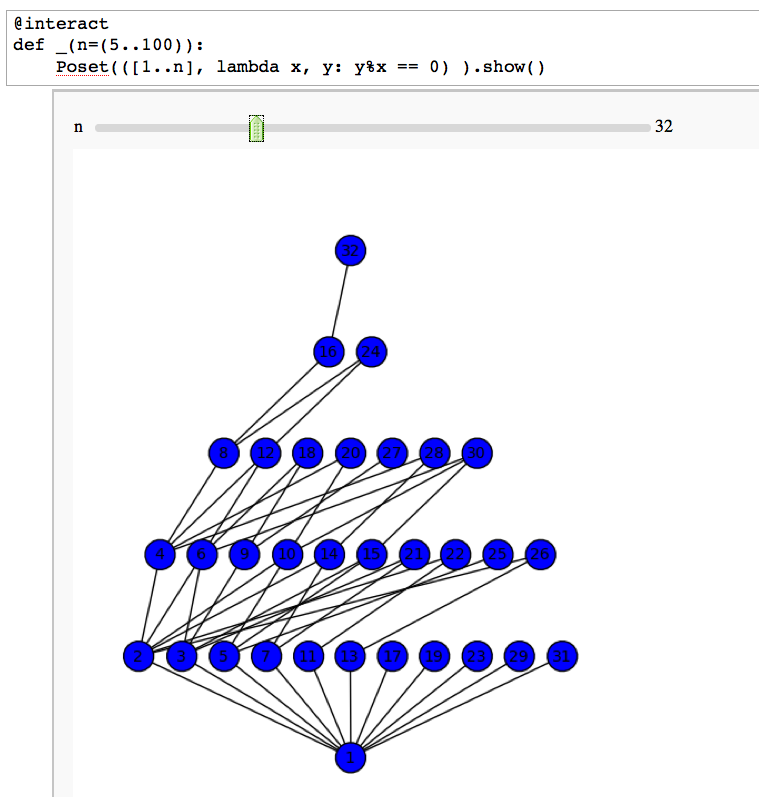
Factor Trees
by William Stein
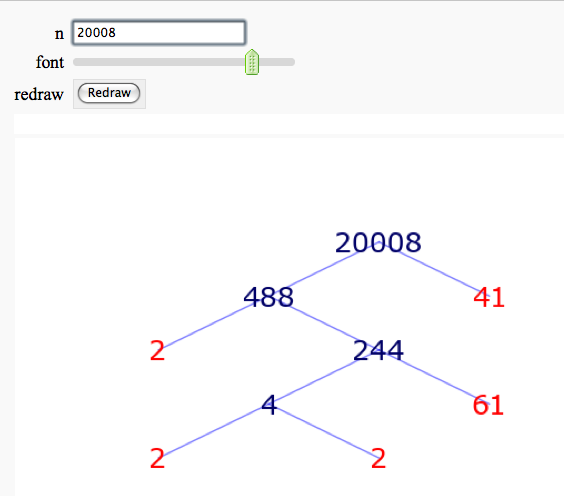
More complicated demonstration using Mathematica: http://demonstrations.wolfram.com/FactorTrees/
Factoring an Integer
by Timothy Clemans
Sage implementation of the Mathematica demonstration of the same name. http://demonstrations.wolfram.com/FactoringAnInteger/
Prime Numbers
Illustrating the prime number theorem
by William Stein
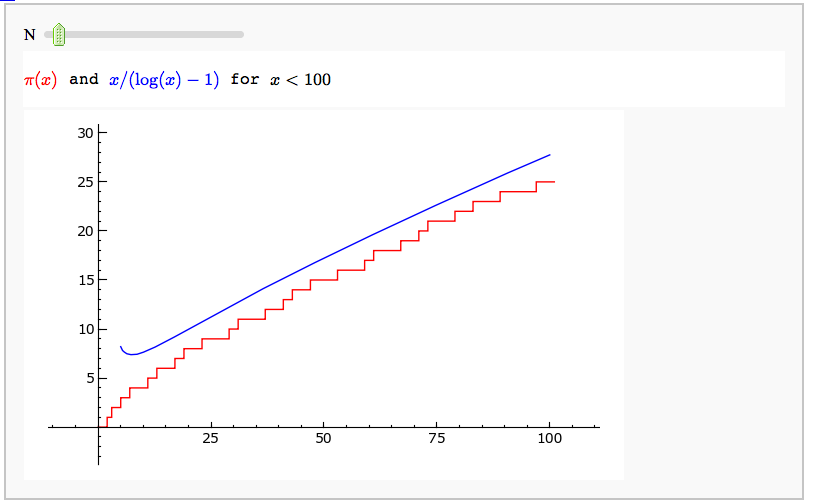
Prime Spiral - Square FIXME
by David Runde
Prime Spiral - Polar
by David Runde
Modular Forms
Computing modular forms
by William Stein
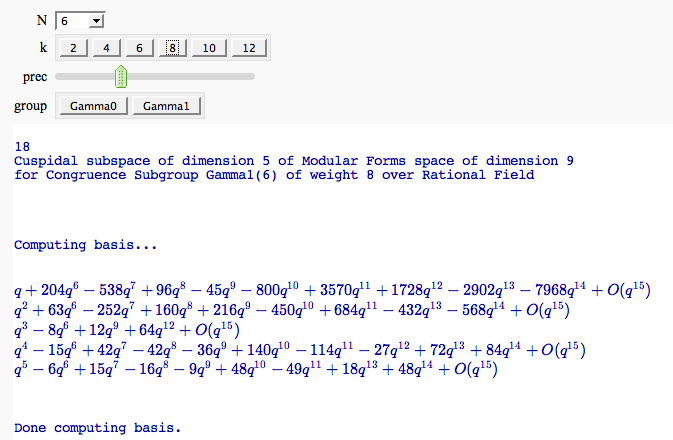
Computing the cuspidal subgroup
by William Stein

A Charpoly and Hecke Operator Graph
by William Stein
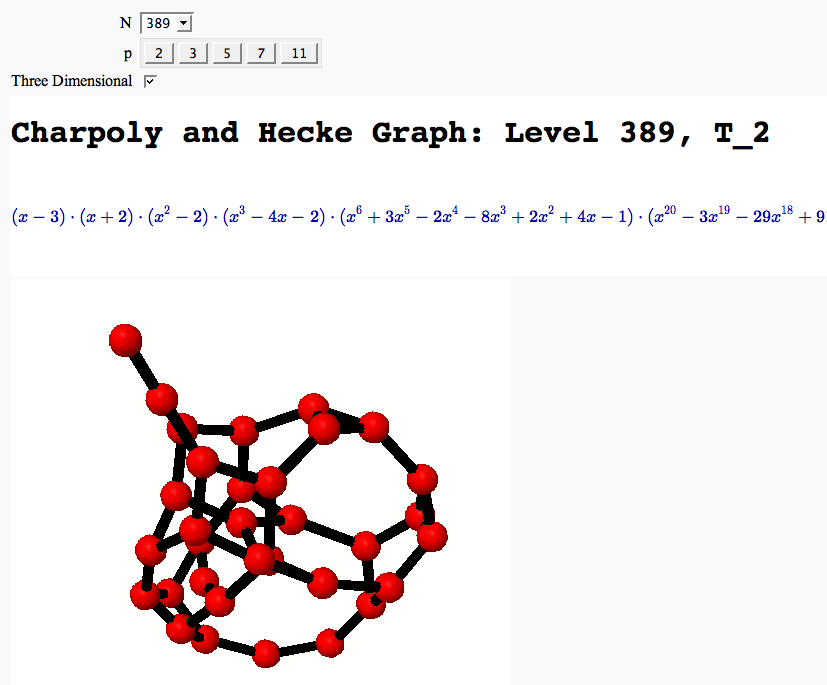
Modular Arithmetic
Quadratic Residue Table FIXME
by Emily Kirkman
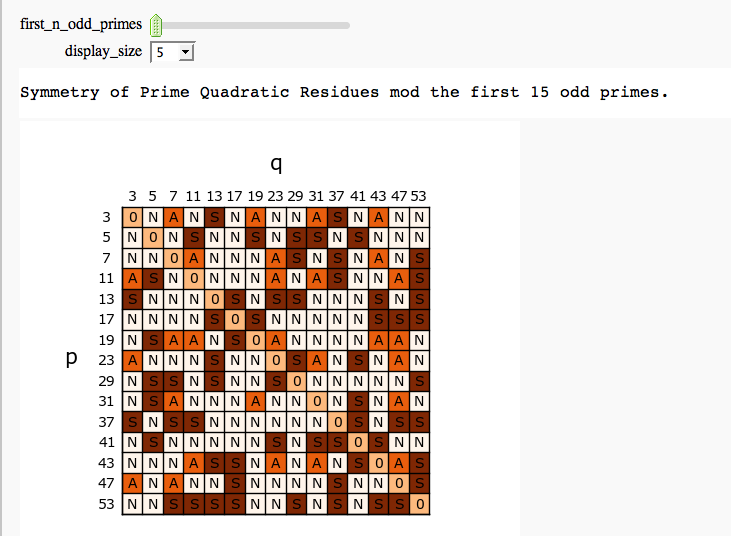
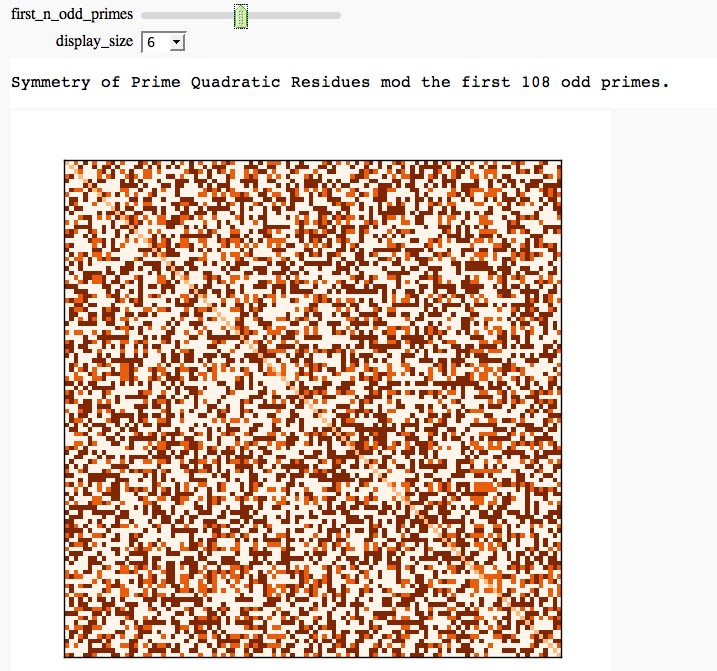
Cubic Residue Table FIXME
by Emily Kirkman

Cyclotomic Fields
Gauss and Jacobi Sums in Complex Plane
by Emily Kirkman
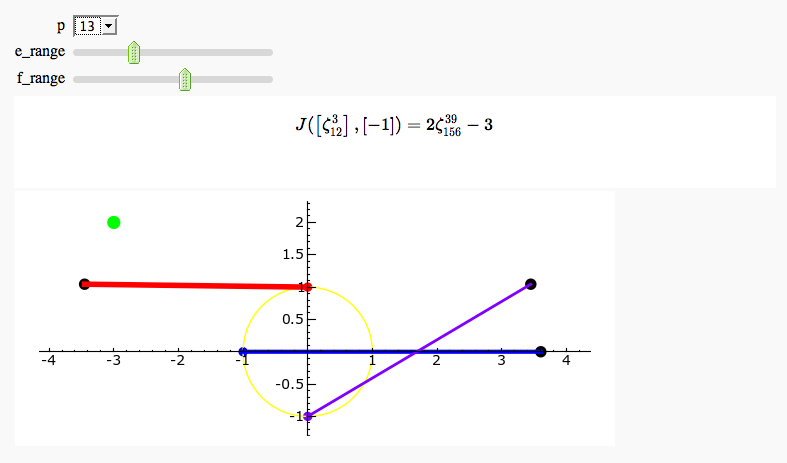
Exhaustive Jacobi Plotter
by Emily Kirkman
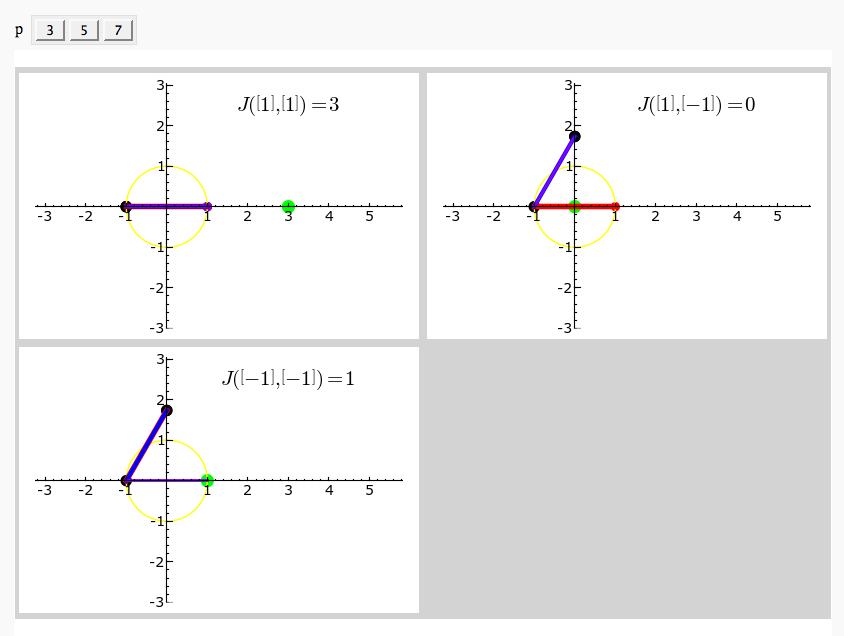
Elliptic Curves
Adding points on an elliptic curve
by David Møller Hansen
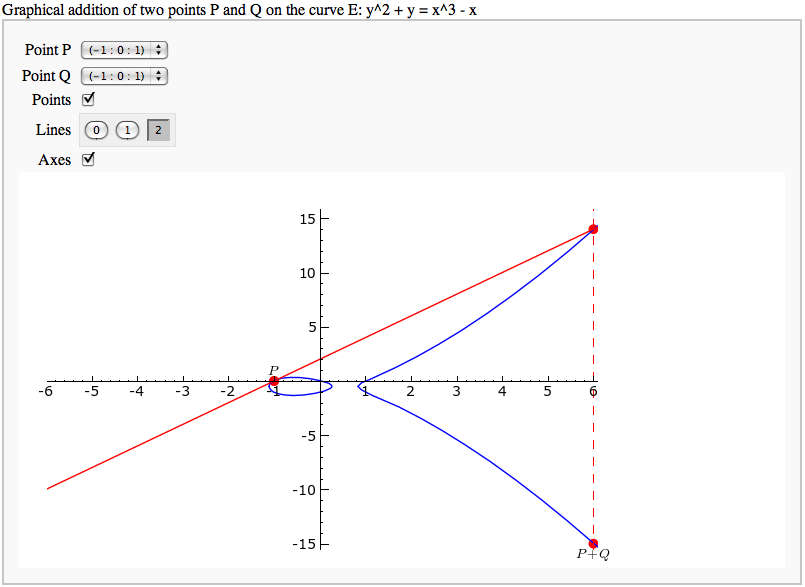
Plotting an elliptic curve over a finite field
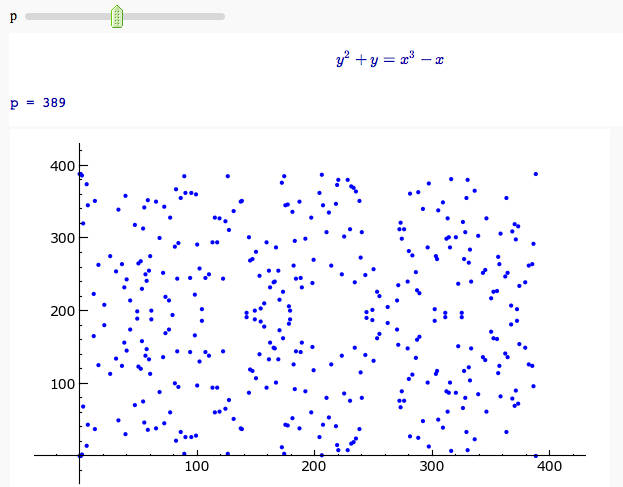
Cryptography
The Diffie-Hellman Key Exchange Protocol
by Timothy Clemans and William Stein
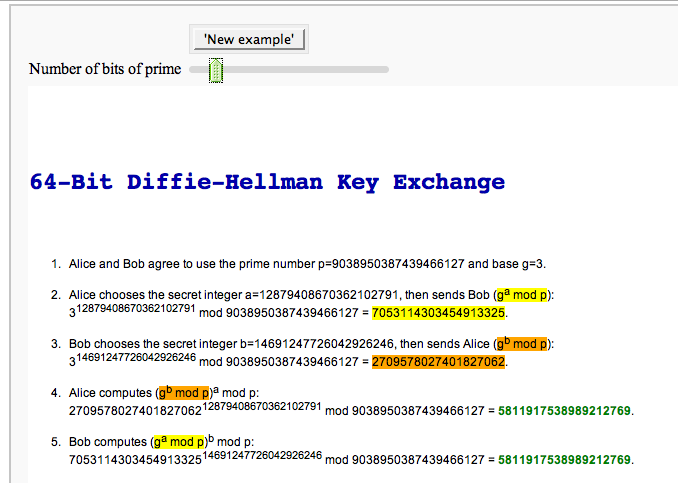
Other
Continued Fraction Plotter
by William Stein
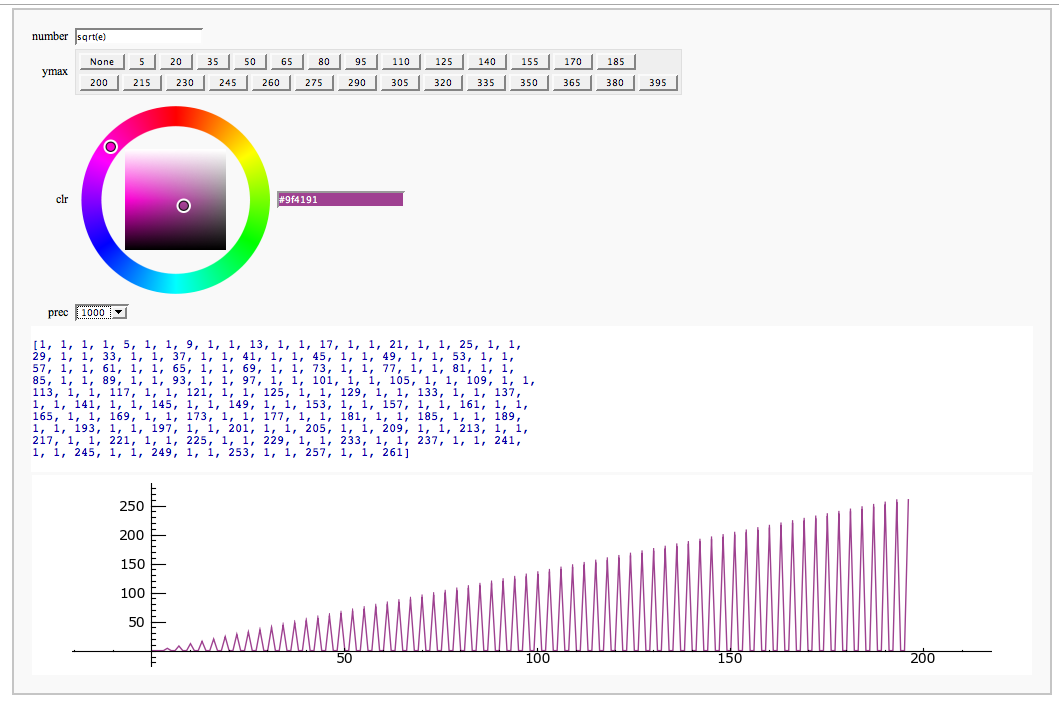
Computing Generalized Bernoulli Numbers
by William Stein (Sage-2.10.3)
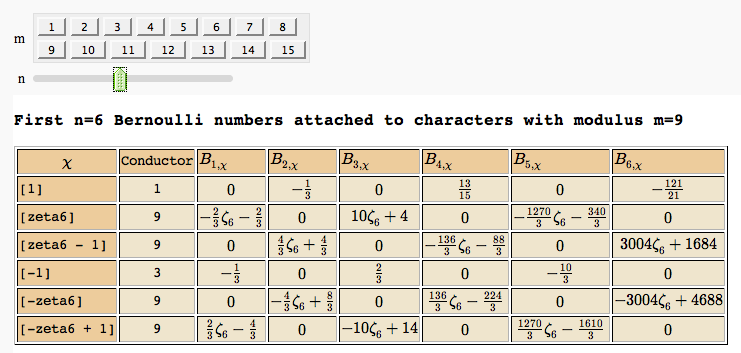
Fundamental Domains of SL_2(ZZ)
by Robert Miller
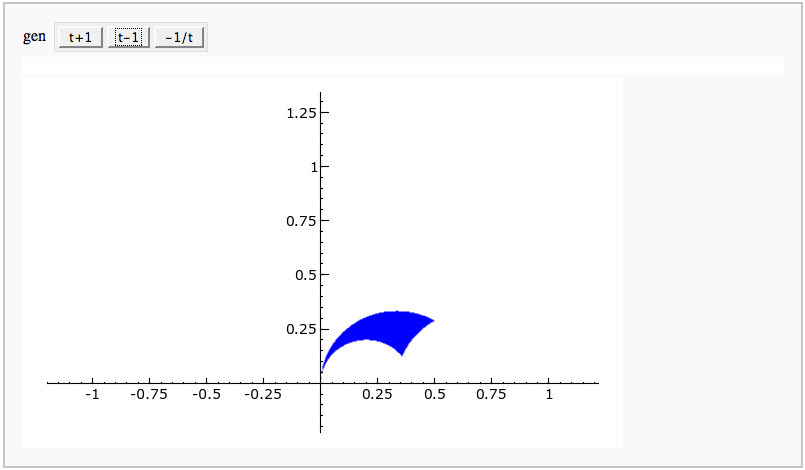
Multiple Zeta Values
by Akhilesh P.
Word to composition
Computing Multiple Zeta values

